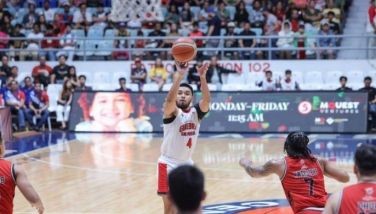Bangus fish cage culture
August 29, 2004 | 12:00am
The fisherfolk’s cry for livelihood that will provide them with their basic needs is a priority concern in Reg. 10, where the Bureau of Fisheries and Aquatic Resources-Fisheries Resource Management Project (FRMP) has started various livelihood projects. The first microenterprise project started was bangus production in marine net cages established in Sitio Guiwanon, Talisayan, Misamis Oriental.
Central to the Guiwanon project is growing milkfish or bangus, not in fishponds, but in two-module, four-unit fish cages measuring 6 m x 6 m x 3 m, made of bamboo and kept afloat by plastic containers. The grow-out contraption is made of polyethylene net and covered to prevent escape of the milkfish. It now benefits 61 fishers and their families who are members of the Talisayan United Fisherfolk Cooperative (TUFIMCO), established under FRMP auspices.
FRMP is a six year project being implemented by the Bureau of Fisheries and Aquatic Resources (BFAR) with funding from the Asian Development Bank and the Japan Bank for International Cooperation. The project aims to reverse fisheries depletion and bring relief to impoverished fisherfolk in 100 municipalities bordering 18 critical bays and gulfs in the country. The project also aims to enhance the capacities of FRMP partners operating in local government units, fisher communities and non-government organizations in participating in fisheries and coastal resource management. FRMP will be implemented until end-2005.
Milkfish culture in marine net cages is a mariculture technology that meets the increasing demand for milkfish in an area where the population is increasing, while marine fisheries stocks are dwindling. Milkfish remains as one of the more affordable fish foods in the country.
With its milkfish culture in cages, BFAR-FRMP Reg. 10 has transformed a cove in the municipality of Talisayan into what it hopes can become the milkfish mariculture capital of the region.
"Aside from providing alternative livelihood to Talisayan’s fishers, the venture can also spin off various economic pursuits such as trading and vending and processing of various milkfish products," said BFAR-FRMP Reg. 10 Regional Director Arlene Pantanosas. It is a major support sector to the germinating food service enterprises in the town.
Talisayan is a fifth class municipality located 83 kms from Cagayan de Oro City, and two towns away from Gingoog City. Its coastal marine resources is rated very good to excellent, with diverse coral species at Sipaka Point, near where the fish cages have been situated. The coastal communities are highly dependent on fishing, and the most popular catch are squid, parrotfish, and siganids.
From January to April of each year, the endangered whale sharks and dolphins migrate to Talisayan’s coastal shores, within easy reach of whale shark hunters who made easy killing in the past of these creatures. These creatures’ meat and liver oil are sold locally and internationally as delicacies and for medical purposes.
Today, under the provisions of the Convention on the International Trade of Endangered Species, whale sharks and dolphins cannot be caught legally. This has put out of work those engaged in the trade.
"Most of the participating fishers in the project have been displaced by the international ban against the capture of the whale sharks. Hence, this project will not just spin off employment for the displaced fishers, but also allow some measure to protect and repopulate the whale sharks," added Dir. Pantanosas.
The bangus fishcage culture project aims to train and develop the entrepreneurial skills of fisherfolk-whale shark hunters and displaced compressor fishers, another group of illegal fishers displaced by vigorous enforcement of relevant fisheries law. With training, their skills to manage the fish cage project are now being developed, at the same time, showcasing and demonstrating the potential and viability of bangus production in fish cages using modular system in the town.
All tasks related to the maintenance of the fish cages have been rotated among the project beneficiaries. Even at night, the fish cages are guarded to ensure against theft.
Through milkfish culture, the beneficiaries are now earning extra income. The first harvest on Nov. 10, 2003 yielded only 492 kilos, a far cry from the one ton harvest expected. However, in the second harvest made on Dec. 12, 2003, a bountiful 933 kilos of marketable bangus were gathered from one of the cages by the members of the cooperative led by Carlito Rayon, TUFIMCO chairman.
The primary targets of the milkfish produced by the project are the seven eateries operating in Talisayan’s seafront, which offer fresh fishes, and the wara-wara or fish stalls along the highway. Sold locally at P65 per kilo, the income the fisherfolk get from the project is considered substantial, compared to catching fish in the wild.
Some of Talisayan’s milkfish have already found their way into nearby municipalities. With technical assistance provided by BFAR-FRMP, and with discipline in holding on to a portion of their revenue so they could expand operations later, the beneficiaries are keeping their fingers crossed that, in time, they could supply the major supermarket chains of Cagayan de Oro with milkfish grown in the waters of Talisayan.
Central to the Guiwanon project is growing milkfish or bangus, not in fishponds, but in two-module, four-unit fish cages measuring 6 m x 6 m x 3 m, made of bamboo and kept afloat by plastic containers. The grow-out contraption is made of polyethylene net and covered to prevent escape of the milkfish. It now benefits 61 fishers and their families who are members of the Talisayan United Fisherfolk Cooperative (TUFIMCO), established under FRMP auspices.
FRMP is a six year project being implemented by the Bureau of Fisheries and Aquatic Resources (BFAR) with funding from the Asian Development Bank and the Japan Bank for International Cooperation. The project aims to reverse fisheries depletion and bring relief to impoverished fisherfolk in 100 municipalities bordering 18 critical bays and gulfs in the country. The project also aims to enhance the capacities of FRMP partners operating in local government units, fisher communities and non-government organizations in participating in fisheries and coastal resource management. FRMP will be implemented until end-2005.
Milkfish culture in marine net cages is a mariculture technology that meets the increasing demand for milkfish in an area where the population is increasing, while marine fisheries stocks are dwindling. Milkfish remains as one of the more affordable fish foods in the country.
With its milkfish culture in cages, BFAR-FRMP Reg. 10 has transformed a cove in the municipality of Talisayan into what it hopes can become the milkfish mariculture capital of the region.
"Aside from providing alternative livelihood to Talisayan’s fishers, the venture can also spin off various economic pursuits such as trading and vending and processing of various milkfish products," said BFAR-FRMP Reg. 10 Regional Director Arlene Pantanosas. It is a major support sector to the germinating food service enterprises in the town.
Talisayan is a fifth class municipality located 83 kms from Cagayan de Oro City, and two towns away from Gingoog City. Its coastal marine resources is rated very good to excellent, with diverse coral species at Sipaka Point, near where the fish cages have been situated. The coastal communities are highly dependent on fishing, and the most popular catch are squid, parrotfish, and siganids.
From January to April of each year, the endangered whale sharks and dolphins migrate to Talisayan’s coastal shores, within easy reach of whale shark hunters who made easy killing in the past of these creatures. These creatures’ meat and liver oil are sold locally and internationally as delicacies and for medical purposes.
Today, under the provisions of the Convention on the International Trade of Endangered Species, whale sharks and dolphins cannot be caught legally. This has put out of work those engaged in the trade.
"Most of the participating fishers in the project have been displaced by the international ban against the capture of the whale sharks. Hence, this project will not just spin off employment for the displaced fishers, but also allow some measure to protect and repopulate the whale sharks," added Dir. Pantanosas.
The bangus fishcage culture project aims to train and develop the entrepreneurial skills of fisherfolk-whale shark hunters and displaced compressor fishers, another group of illegal fishers displaced by vigorous enforcement of relevant fisheries law. With training, their skills to manage the fish cage project are now being developed, at the same time, showcasing and demonstrating the potential and viability of bangus production in fish cages using modular system in the town.
All tasks related to the maintenance of the fish cages have been rotated among the project beneficiaries. Even at night, the fish cages are guarded to ensure against theft.
Through milkfish culture, the beneficiaries are now earning extra income. The first harvest on Nov. 10, 2003 yielded only 492 kilos, a far cry from the one ton harvest expected. However, in the second harvest made on Dec. 12, 2003, a bountiful 933 kilos of marketable bangus were gathered from one of the cages by the members of the cooperative led by Carlito Rayon, TUFIMCO chairman.
The primary targets of the milkfish produced by the project are the seven eateries operating in Talisayan’s seafront, which offer fresh fishes, and the wara-wara or fish stalls along the highway. Sold locally at P65 per kilo, the income the fisherfolk get from the project is considered substantial, compared to catching fish in the wild.
Some of Talisayan’s milkfish have already found their way into nearby municipalities. With technical assistance provided by BFAR-FRMP, and with discipline in holding on to a portion of their revenue so they could expand operations later, the beneficiaries are keeping their fingers crossed that, in time, they could supply the major supermarket chains of Cagayan de Oro with milkfish grown in the waters of Talisayan.
BrandSpace Articles
<
>
- Latest
Latest
Latest
May 14, 2024 - 3:43pm
By Ian Laqui | May 14, 2024 - 3:43pm
April 10, 2024 - 5:12pm
By Ian Laqui | April 10, 2024 - 5:12pm
March 4, 2024 - 3:32pm
By Ian Laqui | March 4, 2024 - 3:32pm
March 4, 2024 - 2:12pm
By Kristine Daguno-Bersamina | March 4, 2024 - 2:12pm
February 17, 2024 - 2:31pm
February 17, 2024 - 2:31pm
Recommended




























